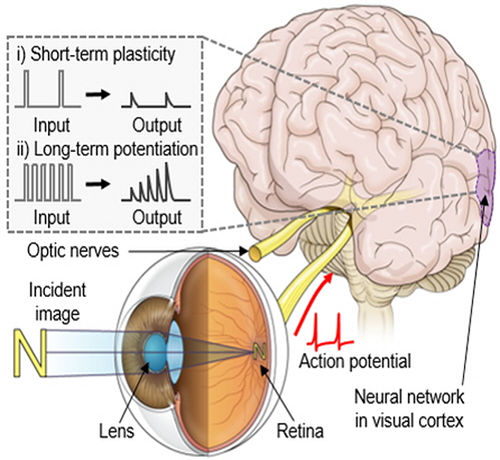2020 Curved Neuromorphic Image Sensor Array Using a MoS2-organic Heterostructure Inspired by the Human Visual Recognition System
본문
- Journal
- Nature Communications
- Vol
- 11
- Page
- 5934
- Year
- 2020
- Link
- https://www.nature.com/articles/s41467-020-19806-6 1192회 연결
Conventional imaging and recognition systems require an extensive amount of data storage, pre-processing, and chip-to-chip communications as well as aberration-proof light focusing with multiple lenses for recognizing an object from massive optical inputs. This is because separate chips (i.e., flat image sensor array, memory device, and CPU) in conjunction with complicated optics should capture, store, and process massive image information independently. In contrast, human vision employs a highly efficient imaging and recognition process. Here, inspired by the human visual recognition system, we present a novel imaging device for efficient image acquisition and data pre-processing by conferring the neuromorphic data processing function on a curved image sensor array. The curved neuromorphic image sensor array is based on a heterostructure of MoS2 and poly(1,3,5-trimethyl-1,3,5-trivinyl cyclotrisiloxane). The curved neuromorphic image sensor array features photon-triggered synaptic plasticity owing to its quasi-linear time-dependent photocurrent generation and prolonged photocurrent decay, originated from charge trapping in the MoS2-organic vertical stack. The curved neuromorphic image sensor array integrated with a plano-convex lens derives a pre-processed image from a set of noisy optical inputs without redundant data storage, processing, and communications as well as without complex optics. The proposed imaging device can substantially improve efficiency of the image acquisition and recognition process, a step forward to the next generation machine vision.
- 이전글Toward Full-Color Electroluminescent Quantum Dot Displays 24.06.14
- 다음글Self-assembly for Electronics 24.06.14

